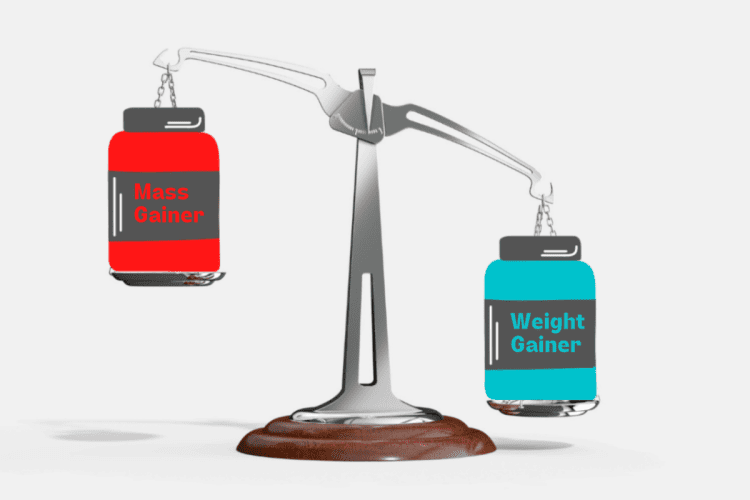Table of Contents
So, you are looking to buy a muscle-building gym supplement and have managed to narrow down your choices to two.
Now, you find yourself stuck choosing between a mass gainer and a casein protein powder.
While both are fitness supplements, they do not belong to the same sub-category. A mass gainer is formulated to help you gain mass via a caloric surplus.
On the other hand, a casein protein supplement is formulated to help you gain mass through the delivery of high-quality protein.
But, if you really had to pick between the two, the information I’ll provide you in this article will help you determine which supplement fulfills your individual needs best.
“Better” Depends on Your Fitness Goal
Even if gaining mass is your goal, you should not be so quick to opt for a mass gainer. Just because they use the same two words, it doesn’t mean that it’s the best pick.
You have to be very precise with what you are after. What does “mass gain” mean to you?
Adding mass can specifically mean putting on lean muscle tissue. At the same time, it can simply mean adding bulk to your frame in any form, fat or muscle.
If your goal is to gain lean body mass, casein is best.
The lower calories and low-to-no carb content make it easy to fit, account for, calculate and integrate into your nutrition plan.
It is also best for competing bodybuilders and athletes that have a meticulous nutrition protocol to follow.
Now if your goal is to simply gain weight or if you are a fan of “dirty bulks”, then a mass gainer is the best choice. It will make going over your calorie needs easy with just a serving or two.
Plus, it can be used by skinny, lanky guys who find it hard and torturous to eat plate after plate of food. Mass gainers can also be incorporated in the diet plans of powerlifters or Strongman competitors that prefer gaining fat along with muscle to increase their leverage over the ungodly amounts of weight they heave.
What They Have In Common
One thing mass gainers and casein supplements have in common is that they deliver a good amount of protein per serving, around 20-30 grams for casein and 40-60 for a mass gainer.
Protein is the most essential macronutrient for building muscle
It provides the body a stream of amino acids that are used to repair damaged muscle tissue during bouts of resistance training.
This muscle-building ingredient is what you need most of, regardless of what your fitness goal is. In fact, they both carry a good amount of these anabolic compounds; so, where do they differ?
The Protein Quality Matters
Are the proteins in mass gainers and casein the same? Well, no, but sometimes yes. Let me explain…
First, mass gainers sometimes sacrifice quality for quantity and affordability, which is done in good faith.
While the proteins in mass gainers are complete proteins, they are often sourced from whey, egg, soy, pea, or animal protein – all abundant and comparatively cheaper protein sources. Whey, for example, is sourced from waste byproducts of milk processing plants.
Second, casein comes from actual milk, it is not a byproduct or leftover. So, manufacturers have to pay a higher price for them. But, it is well worth the cost since its properties make it one of the highest, if not the highest, quality protein out there.
Casein protein is the premiere complete protein. As a result, manufacturers rarely add them to mass gainers because they can significantly increase prices. Because of this, they are often mixed with other protein sources. You can read more about casein in detail here
Lastly, in the pursuit of quality, some manufacturers incorporate casein into their mass gainers.
Not only do you have a high-calorie drink to help you reach the number of excess calories you need for a surplus, but you also get the best quality protein that doubles muscle growth and triples fat loss [1].
So, if your aim is quantity (of calories) and a more budget-friendly supplement, go for a mass gainer.
If quality muscle and overall optimal health is the goal, then pick a tub of casein powder instead. However, do keep in mind the disparity in overall calories between the two.
Casein Mass Gainers
If you have a hard time choosing between casein and a mass gainer, then a combination of both inside one product would probably solve your problem. And lucky for you, there are products like this available on the market.
Most mass gainers have a milk protein as their main protein source; most of the time it is a mix of whey and casein.
Since manufacturers try to have several sources for their macros to resemble food variety, it is hard to find a mass gainer with a pure casein protein source.
Still, a mass gainer with casein will prove superior to other gainers without it.
To make picking a casein mass gainer for you easier, let’s first have a quick rundown of the three types of casein protein:
- Micellar casein – slow-digesting type; best used pre-bed
- Casein hydrolysate – quick-absorbing; absorbed intact for high net protein balance
- Calcium caseinate – quick-absorbing; boosts fat loss
A combination of fast and slow-digesting protein makes sure you have a steady supply of amino acids available throughout the day.
This puts you in a constantly anabolic state. So, opt for this combo in your mass gainer if you can.
For the hardcore bodybuilder or powerlifter, Mutant Mass contains both micellar casein and calcium caseinate. It delivers 1100 calories per serving with 56 grams of protein and 192 grams of carbs.
Although it might not make you as huge as Rich Piana but it will surely help you build your physique with its “time-release protein” formulation.
If you’re one of those gluten-fearing, organic-loving, all-natural fitness folks, you can opt for Naked Nutrition’s Naked Mass.
Its ingredients include casein and whey for protein as well as organic carb sources. With 1360 calories per serving, you are sure to hit your macro goals with no problem.
The Bottom Line
By now, you have probably figured out that between a mass gainer and a casein powder, it is hard to objectively choose which one is best because as usual, it depends!
We have different fitness goals, we are at different stages in achieving those goals, and we have different resources. The “best” supplement will depend on all of these user-specific factors.





